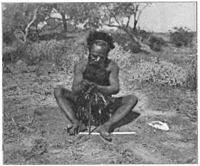Arabana language facts for kids
Quick facts for kids Arabana |
||||
|---|---|---|---|---|
| Arabana-Wangkangurru | ||||

|
||||
| Region | South Australia; west side Lake Eyre to Stuart Range, Maree, Port Augusta | |||
| Ethnicity | Arabana people, Wongkanguru | |||
| Native speakers | 31 (2021 census) | |||
| Language family |
Pama–Nyungan
|
|||
| Dialects |
Arabana
Pilta-Palta
Wangkakupa
Midlaliri
Mikiri-nganha
|
|||
| AIATSIS | L13 Arabana (cover term), L27 | |||

|
||||
|
||||
Arabana (also called Arabuna) is an Aboriginal language from Australia. It belongs to the Pama–Nyungan language family. The Wongkanguru and Arabana people traditionally speak this language.
Sadly, the Arabana language is in serious danger of disappearing. In 2004, about 250 people spoke it. By 2021, only 31 speakers were recorded. This means it's a critically endangered language.
Where the Arabana Language is Spoken
The Arabana language was traditionally spoken in a large area of South Australia. This region stretches from the Neales River on the west side of Lake Eyre. It goes west towards the Stuart Range.
The language area also includes Macumba Creek south to Coward Springs. You would also find Arabana speakers in places like Oodnadatta, Lora Creek, Lake Cadibarrawirracanna, and The Peake. The western edge of their land, near Coober Pedy, bordered the Kokatha People.
Different Ways to Speak Arabana
Just like how different regions might have different accents or words, languages often have "dialects." A dialect is a special form of a language that is used in a specific area or by a specific group of people.
The Arabana language has a few different dialects:
- Piltapalta: This was considered the main or "proper" Arabana dialect.
- Wangkakupa
- Midhaliri
The Wangganguru language was also sometimes thought of as a dialect of Arabana.

